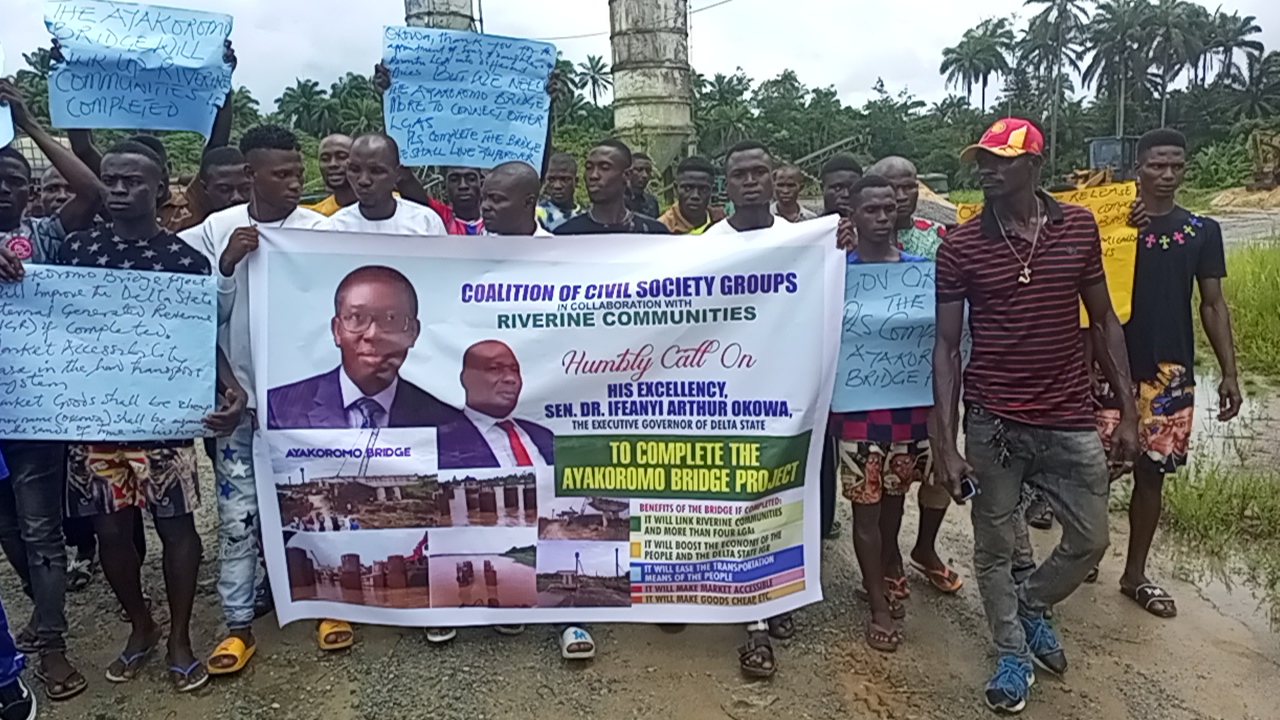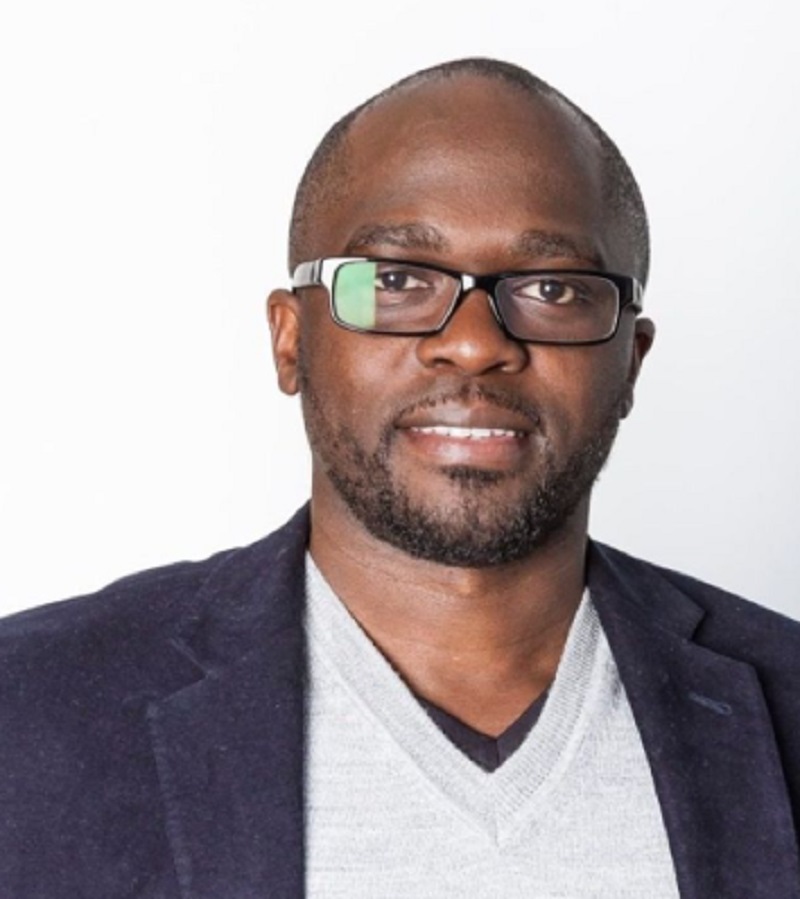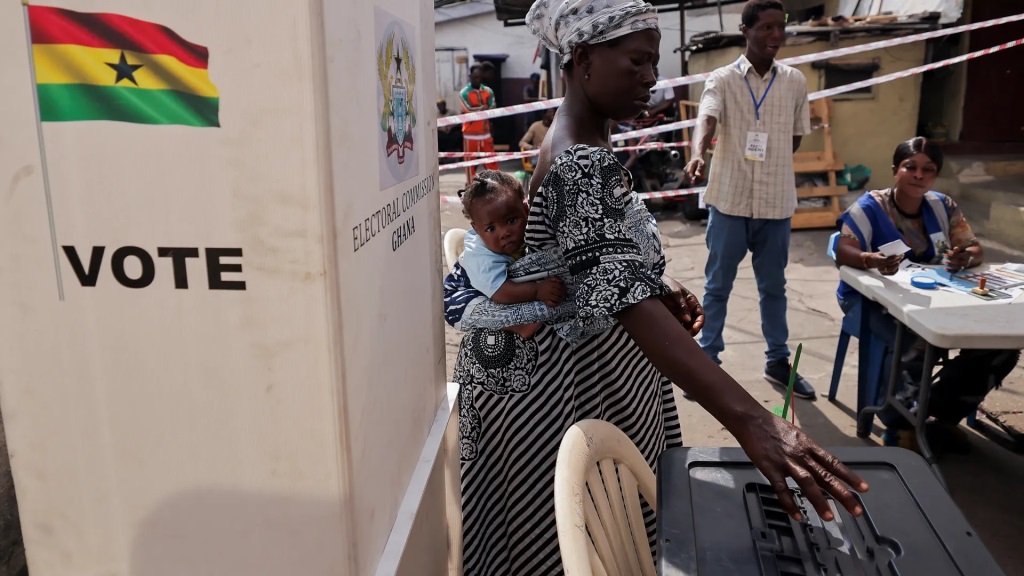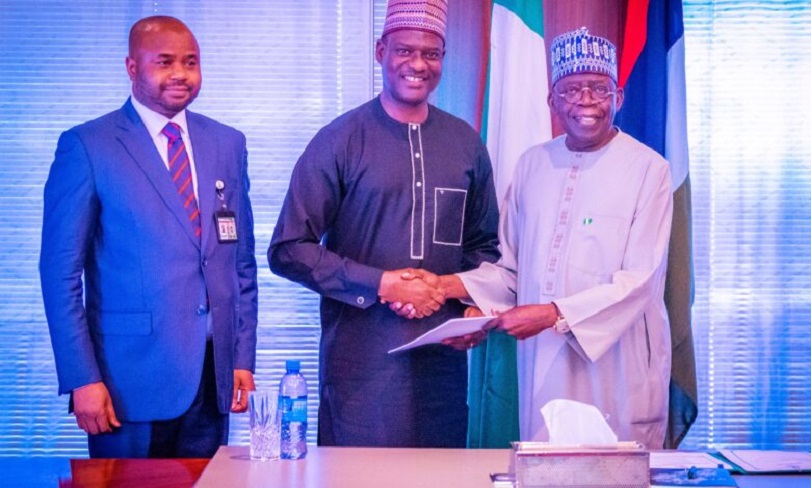Feature/OPED
Ayakoromo Bridge and False Hopes

By Jerome-Mario Chijioke Utomi
It is no longer news that the Delta State Government recently addressed the media on the multi-billion naira contract for the construction of the Ayakoromo Bridge in the Burutu Local Government Area of the state, stating that it has cancelled the contract for the bridge due to poor performance by the contractor.
At first glance, the latest action for me depicts Delta State government as an administration that is internally directed, people-focused, externally open and above all, a right step taken in the right direction, particularly as such action is long overdue.
However, as an author that has in the past supported and will continue to support good intentions coming from the present administration in the state, particularly when such actions are directed towards uplifting the life chances of the people, the truth must be told to the effect that in the present circumstance, the newest action by the state government only confirm as true the words of Winston Churchill, a onetime Prime Minister of Great Britain, that ‘there is no worse mistake in public leadership than to hold out false hopes soon to be swept away.
For a very long time, the state government has given false hopes to the people of the Ayakromo community and Deltans as a whole about the true condition of the bridge.
Governor Ifeanyi Okowa persistently failed to reveal the true bill of the contractor’s technical health/know-how even when it was glaringly obvious to Deltans with critical minds that the contractor was technically-challenged. Most brazenly, Okowa’s administration failed to remember that, as a general rule, the first step to solving a problem is to admit that one exists. But instead of going by this rule, the state government told Deltans that the bridge was 60% near completion, even when the Key Performance Indicators (KPIs) pointed otherwise.
Take, for instance, when the administration learnt in January 2020 that the Ijaw Peoples Development Initiative and Ayakoromo youths planned a protest against the ‘abandonment’ of the bridge, the Okowa-led administration, through the Commissioner for Information, Charles Aniagwu, in a statement in Asaba, stated that the state leadership was committed to the completion of road projects it has embarked on.
He added that the Ayakoromo bridge project had not been abandoned and urged the groups to shun their planned protest. The statement also noted that the state government had already made provisions for the completion of the bridge in the 2020 budget and was desirous to complete the project.
Again, six months after that statement, precisely in June 2020, the Delta State Government, in a similar style, assured that the Ayakoromo Bridge would be vigorously executed as a top priority project. This time around, the Commissioner for Works, Chief James Aguoye, made the disclosure in Ayakoromo while speaking to newsmen.
Aguoye, according to media reports, said that the project had a budgetary provision of N1 billion in the 2020 budget. The Commissioner added that the project would be up-scaled in 2021.
In January 2022, after the first executive council meeting, which was presided over by Governor Okowa, the Commissioner for Information, Mr Charles Aniagwu, announced that the Delta State government has recently approved an upward review of the contract cost of the Ayakoromo Bridge project from N6 billion to N10.5 billion, noting that the review was necessary as a result of present economic realities in the country.
Even government supporters were not left out in the now-ended season of lies and blind support.
For instance, when I did a piece titled Ayakromo Bridge, One Abandonment too many, the referenced piece, among other concerns, expressed/underlined the urgency of having the contractor sacked. And in his place, have a new contractor appointed backed with adequate funds, superior technical skills and experience to replace the current contractor, who obviously lacks the wherewithal to complete the bridge.
The reactions that trailed this objective submission by the piece could be seen better than imagined.
Some commentators argued that even in a democracy, the government is at liberty to take or discard advice and public opinion in the interest of the greater good for the greater number.
Public opinion, in their view, does not always provide clear-cut policy guidance, and even when it is clearly in favour of a certain course of government action, the authorities may decide otherwise-particularly when they realize how uninformed, superficial, and changeable most opinions really are. To others, the government may also reject people’s opinions as a result of its convictions, the recommendations of the public service, or the pressure of advocacy groups
To the rest, whenever the government fails to follow a clear-cut preference among the public opinion, they may actually be relying on a deeper understanding of the issue, the greater information at their disposal, a more sophisticated analysis of its implications, a concern for minority groups’ rights, or a less prejudicial attitude.
Now that the season of denial and argument has ended, the question that is as important as the piece itself is; what is the fate of Ayakromo Bridge? Will it still be completed by the present administration, or has to be handed to the incoming administration? Would it be considered a good commentary that the Governor inherited from his predecessor a bridge under construction that is far less than one kilometre yet could not complete in eight years?
While answers to the above questions are being anticipated, I must quickly add that the underlying objective of this piece is not to chastise any individual or group but to draw the attention of the Okowa-led government to this mess in ways that will assist him in performing the traditional but universal responsibility of provision of economic and infrastructural succour to the citizenry, which the instrumentality of participatory democracy and election of leaders confers on him.
The government must give the desired new lease of life and satisfactory service/governance to the community’s people. Above all, the state government must design more creative and development-focused ways to serve and save Deltans holistically.
Finally, as noted in my previous intervention on this topic, the state government must not fail to remember that the Bobougbene community and its environs in Burutu LGA are reputed for producing palm oil in commercial quantity and supply of same to Warri metropolis and Okwumagbe markets in Ughelli-South LGA. The bridge, when completed, will provide easy access to these markets. This is a very important reason why the state must pay disciplined attention to that project. It must not, for any reason, be abandoned.
Jerome-Mario Chijioke Utomi of Social and Economic Justice Advocacy writes from Lagos; 08032725374
Feature/OPED
The Future of Payments: Key Trends to Watch in 2025

By Luke Kyohere
The global payments landscape is undergoing a rapid transformation. New technologies coupled with the rising demand for seamless, secure, and efficient transactions has spurred on an exciting new era of innovation and growth. With 2025 fast approaching, here are important trends that will shape the future of payments:
1. The rise of real-time payments
Until recently, real-time payments have been used in Africa for cross-border mobile money payments, but less so for traditional payments. We are seeing companies like Mastercard investing in this area, as well as central banks in Africa putting focus on this.
2. Cashless payments will increase
In 2025, we will see the continued acceleration of cashless payments across Africa. B2B payments in particular will also increase. Digital payments began between individuals but are now becoming commonplace for larger corporate transactions.
3. Digital currency will hit mainstream
In the cryptocurrency space, we will see an increase in the use of stablecoins like United States Digital Currency (USDC) and Tether (USDT) which are linked to US dollars. These will come to replace traditional cryptocurrencies as their price point is more stable. This year, many countries will begin preparing for Central Bank Digital Currencies (CBDCs), government-backed digital currencies which use blockchain.
The increased uptake of digital currencies reflects the maturity of distributed ledger technology and improved API availability.
4. Increased government oversight
As adoption of digital currencies will increase, governments will also put more focus into monitoring these flows. In particular, this will centre on companies and banks rather than individuals. The goal of this will be to control and occasionally curb runaway foreign exchange (FX) rates.
5. Business leaders buy into AI technology
In 2025, we will see many business leaders buying into AI through respected providers relying on well-researched platforms and huge data sets. Most companies don’t have the budget to invest in their own research and development in AI, so many are now opting to ‘buy’ into the technology rather than ‘build’ it themselves. Moreover, many businesses are concerned about the risks associated with data ownership and accuracy so buying software is another way to avoid this risk.
6. Continued AI Adoption in Payments
In payments, the proliferation of AI will continue to improve user experience and increase security. To detect fraud, AI is used to track patterns and payment flows in real-time. If unusual activity is detected, the technology can be used to flag or even block payments which may be fraudulent.
When it comes to user experience, we will also see AI being used to improve the interface design of payment platforms. The technology will also increasingly be used for translation for international payment platforms.
7. Rise of Super Apps
To get more from their platforms, mobile network operators are building comprehensive service platforms, integrating multiple payment experiences into a single app. This reflects the shift of many users moving from text-based services to mobile apps. Rather than offering a single service, super apps are packing many other services into a single app. For example, apps which may have previously been used primarily for lending, now have options for saving and paying bills.
8. Business strategy shift
Recent major technological changes will force business leaders to focus on much shorter prediction and reaction cycles. Because the rate of change has been unprecedented in the past year, this will force decision-makers to adapt quickly, be decisive and nimble.
As the payments space evolves, businesses, banks, and governments must continually embrace innovation, collaboration, and prioritise customer needs. These efforts build a more inclusive, secure, and efficient payment system that supports local to global economic growth – enabling true financial inclusion across borders.
Luke Kyohere is the Group Chief Product and Innovation Officer at Onafriq
Feature/OPED
Ghana’s Democratic Triumph: A Call to Action for Nigeria’s 2027 Elections

In a heartfelt statement released today, the Conference of Nigeria Political Parties (CNPP) has extended its warmest congratulations to Ghana’s President-Elect, emphasizing the importance of learning from Ghana’s recent electoral success as Nigeria gears up for its 2027 general elections.
In a statement signed by its Deputy National Publicity Secretary, Comrade James Ezema, the CNPP highlighted the need for Nigeria to reclaim its status as a leader in democratic governance in Africa.
“The recent victory of Ghana’s President-Elect is a testament to the maturity and resilience of Ghana’s democracy,” the CNPP stated. “As we celebrate this achievement, we must reflect on the lessons that Nigeria can learn from our West African neighbour.”
The CNPP’s message underscored the significance of free, fair, and credible elections, a standard that Ghana has set and one that Nigeria has previously achieved under former President Goodluck Jonathan in 2015. “It is high time for Nigeria to reclaim its position as a beacon of democracy in Africa,” the CNPP asserted, calling for a renewed commitment to the electoral process.
Central to CNPP’s message is the insistence that “the will of the people must be supreme in Nigeria’s electoral processes.” The umbrella body of all registered political parties and political associations in Nigeria CNPP emphasized the necessity of an electoral system that genuinely reflects the wishes of the Nigerian populace. “We must strive to create an environment where elections are free from manipulation, violence, and intimidation,” the CNPP urged, calling on the Independent National Electoral Commission (INEC) to take decisive action to ensure the integrity of the electoral process.
The CNPP also expressed concern over premature declarations regarding the 2027 elections, stating, “It is disheartening to note that some individuals are already announcing that there is no vacancy in Aso Rock in 2027. This kind of statement not only undermines the democratic principles that our nation holds dear but also distracts from the pressing need for the current administration to earn the trust of the electorate.”
The CNPP viewed the upcoming elections as a pivotal moment for Nigeria. “The 2027 general elections present a unique opportunity for Nigeria to reclaim its position as a leader in democratic governance in Africa,” it remarked. The body called on all stakeholders — including the executive, legislature, judiciary, the Independent National Electoral Commission (INEC), and civil society organisations — to collaborate in ensuring that elections are transparent, credible, and reflective of the will of the Nigerian people.
As the most populous African country prepares for the 2027 elections, the CNPP urged all Nigerians to remain vigilant and committed to democratic principles. “We must work together to ensure that our elections are free from violence, intimidation, and manipulation,” the statement stated, reaffirming the CNPP’s commitment to promoting a peaceful and credible electoral process.
In conclusion, the CNPP congratulated the President-Elect of Ghana and the Ghanaian people on their remarkable achievements.
“We look forward to learning from their experience and working together to strengthen democracy in our region,” the CNPP concluded.
Feature/OPED
The Need to Promote Equality, Equity and Fairness in Nigeria’s Proposed Tax Reforms

By Kenechukwu Aguolu
The proposed tax reform, involving four tax bills introduced by the Federal Government, has received significant criticism. Notably, it was rejected by the Governors’ Forum but was still forwarded to the National Assembly. Unlike the various bold economic decisions made by this government, concessions will likely need to be made on these tax reforms, which involve legislative amendments and therefore cannot be imposed by the executive. This article highlights the purposes of taxation, the qualities of a good tax system, and some of the implications of the proposed tax reforms.
One of the major purposes of taxation is to generate revenue for the government to finance its activities. A good tax system should raise sufficient revenue for the government to fund its operations, and support economic and infrastructural development. For any country to achieve meaningful progress, its tax-to-GDP ratio should be at least 15%. Currently, Nigeria’s tax-to-GDP ratio is less than 11%. The proposed tax reforms aim to increase this ratio to 18% within the next three years.
A good tax system should also promote income redistribution and equality by implementing progressive tax policies. In line with this, the proposed tax reforms favour low-income earners. For example, individuals earning less than one million naira annually are exempted from personal income tax. Additionally, essential goods and services such as food, accommodation, and transportation, which constitute a significant portion of household consumption for low- and middle-income groups, are to be exempted from VAT.
In addition to equality, a good tax system should ensure equity and fairness, a key area of contention surrounding the proposed reforms. If implemented, the amendments to the Value Added Tax could lead to a significant reduction in the federal allocation for some states; impairing their ability to finance government operations and development projects. The VAT amendments should be holistically revisited to promote fairness and national unity.
The establishment of a single agency to collect government taxes, the Nigeria Revenue Service, could reduce loopholes that have previously resulted in revenue losses, provided proper controls are put in place. It is logically easier to monitor revenue collection by one agency than by multiple agencies. However, this is not a magical solution. With automation, revenue collection can be seamless whether it is managed by one agency or several, as long as monitoring and accountability measures are implemented effectively.
The proposed tax reforms by the Federal Government are well-intentioned. However, all concerns raised by Nigerians should be looked into, and concessions should be made where necessary. Policies are more effective when they are adapted to suit the unique characteristics of a nation, rather than adopted wholesale. A good tax system should aim to raise sufficient revenue, ensure equitable income distribution, and promote equality, equity, and fairness.
-

 Feature/OPED5 years ago
Feature/OPED5 years agoDavos was Different this year
-
Travel/Tourism8 years ago
Lagos Seals Western Lodge Hotel In Ikorodu
-

 Showbiz2 years ago
Showbiz2 years agoEstranged Lover Releases Videos of Empress Njamah Bathing
-

 Banking6 years ago
Banking6 years agoSort Codes of GTBank Branches in Nigeria
-

 Economy2 years ago
Economy2 years agoSubsidy Removal: CNG at N130 Per Litre Cheaper Than Petrol—IPMAN
-

 Banking2 years ago
Banking2 years agoFirst Bank Announces Planned Downtime
-

 Sports2 years ago
Sports2 years agoHighest Paid Nigerian Footballer – How Much Do Nigerian Footballers Earn
-

 Technology4 years ago
Technology4 years agoHow To Link Your MTN, Airtel, Glo, 9mobile Lines to NIN
















